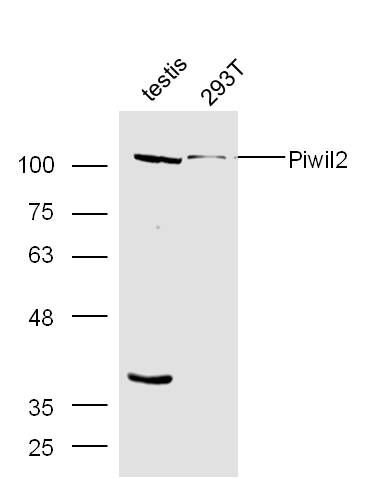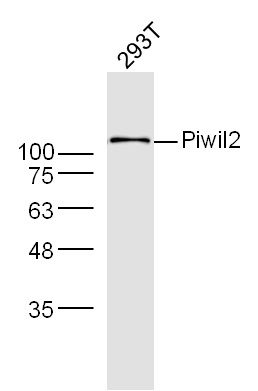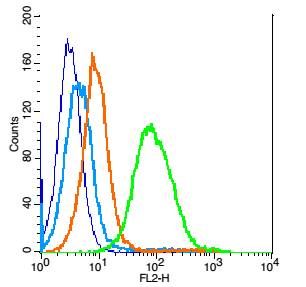产品中心
当前位置:首页>产品中心Anti-Piwil2
货号: bs-3817R 基本售价: 1380.0 元 规格: 100ul
- 规格:100ul
- 价格:1380.00元
- 规格:200ul
- 价格:2200.00元
产品信息
- 产品编号
- bs-3817R
- 英文名称
- Piwil2
- 中文名称
- piwi样2蛋白抗体
- 别 名
- HILI; Hiwi like; MILI; Miwi like; Piwi like 2; Piwi-like 2; Piwil 2; Piwil-2; Piwil2; Cancer/testis antigen 80; CT80; PIWL2_HUMAN; HILI.

- Specific References (1) | bs-3817R has been referenced in 1 publications.[IF=3.64] Shi, Ran-ran, et al. "The immunogenicity of a novel cytotoxic T lymphocyte epitope from tumor antigen PL2L60 could be enhanced by 4-chlorophenylalanine substitution at position 1."?Cancer Immunology, Immunotherapy?(2013): 1-10. WB ; Human.PubMed:24077852
- 规格价格
- 100ul/1380元购买 200ul/2200元购买 大包装/询价
- 说 明 书
- 100ul 200ul
- 研究领域
- 肿瘤 细胞生物 免疫学 信号转导 转录调节因子
- 抗体来源
- Rabbit
- 克隆类型
- Polyclonal
- 交叉反应
- Human, Mouse, Rat, Dog, Pig, Cow, Rabbit, Guinea Pig,
- 产品应用
- WB=1:500-2000 ELISA=1:500-1000 IHC-P=1:400-800 IHC-F=1:400-800 Flow-Cyt=0.2μg /Test IF=1:100-500 (石蜡切片需做抗原修复)
not yet tested in other applications.
optimal dilutions/concentrations should be determined by the end user.
- 分 子 量
- 107kDa
- 细胞定位
- 细胞浆
- 性 状
- Lyophilized or Liquid
- 浓 度
- 1mg/ml
- 免 疫 原
- KLH conjugated synthetic peptide derived from human Piwil2/Mili:885-973/973
- 亚 型
- IgG
- 纯化方法
- affinity purified by Protein A
- 储 存 液
- 0.01M TBS(pH7.4) with 1% BSA, 0.03% Proclin300 and 50% Glycerol.
- 保存条件
- Store at -20 °C for one year. Avoid repeated freeze/thaw cycles. The lyophilized antibody is stable at room temperature for at least one month and for greater than a year when kept at -20°C. When reconstituted in sterile pH 7.4 0.01M PBS or diluent of antibody the antibody is stable for at least two weeks at 2-4 °C.
- PubMed
- PubMed
- 产品介绍
- background:
HILI is a 973 amino acid protein encoded by the human gene PIWIL2. HILI belongs to the argonaute family and contains one PAZ domain and one PIWI domain. HILI is a cytoplasmic protein that is expressed in adult testis and in most tumors. It regulates spermatogenesis and primordial germ cell production and has an essential role in meiotic differentiation of spermatocytes and in self-renewal of spermatogonial stem cells. Expression of HILI can modulate expression of genes involved in stem cell proliferation (such as PDGFR-b), in energy metabolism (such as Glut1), in cell-cell interaction (such as Integrin a6, GJA7, THY-1 and CD9), and in germ cell differentiation (such as STRA8). It may also play a role as a regulatory factor of Stat3/Bcl-xS/L/CCND1 pathway. Repression of HILI can inhibit tumor cell growth. HILI acts as an oncogene by inhibition of apoptosis and promotion of proliferation in tumors.
Function:
Plays a central role during spermatogenesis by repressing transposable elements and prevent their mobilization, which is essential for the germline integrity. Plays an essential role in meiotic differentiation of spermatocytes, germ cell differentiation and in self-renewal of spermatogonial stem cells. Its presence in oocytes suggests that it may participate in similar functions during oogenesis in females. Acts via the piRNA metabolic process, which mediates the repression of transposable elements during meiosis by forming complexes composed of piRNAs and Piwi proteins and govern the methylation and subsequent repression of transposons. Directly binds piRNAs, a class of 24 to 30 nucleotide RNAs that are generated by a Dicer-independent mechanism and are primarily derived from transposons and other repeated sequence elements. Associates with primary piRNAs in the cytoplasm and is required for PIWIL4/MIWI2 nuclear localization and association with secondary piRNAs antisense. The piRNA process acts upstream of known mediators of DNA methylation. Participates in a piRNA amplification loop. Besides their function in transposable elements repression, piRNAs are probably involved in other processes during meiosis such as translation regulation. Indirectly modulate expression of genes such as PDGFRB, SLC2A1, ITGA6, GJA7, THY1, CD9 and STRA8. Inhibits tumor cell growth when repressed. When overexpressed, acts as an oncogene by inhibition of apoptosis and promotion of proliferation in tumors.
Subunit:
Interacts with DDX4, MAEL, EIF3A, EIF4E, EIF4G, PRMT5 and WDR77. Associates with EIF4E- and EIF4G-containing m7G cap-binding complexes. Interacts (when methylated on arginine residues) with TDRD1.
Subcellular Location:
Cytoplasm. Note=Present in chromatoid body. Probable component of the meiotic nuage, also named P granule, a germ-cell-specific organelle required to repress transposon during meiosis.
Tissue Specificity:
Expressed in adult testis and in most tumors.
Post-translational modifications:
Arginine methylation by PRMT5 is required for the interaction with Tudor domain-containing protein TDRD1 and subsequent localization to the meiotic nuage, also named P granule.
Similarity:
Belongs to the argonaute family. Piwi subfamily.
Contains 1 PAZ domain.
Contains 1 Piwi domain.
SWISS:
Q8TC59
Gene ID:
55124
Database links:Entrez Gene: 55124 Human
Entrez Gene: 57746 Mouse
Entrez Gene: 306011 Rat
Omim: 610312 Human
SwissProt: Q8TC59 Human
SwissProt: Q8CDG1 Mouse
Unigene: 614809 Human
Unigene: 85253 Mouse
Unigene: 144968 Rat
Important Note:
This product as supplied is intended for research use only, not for use in human, therapeutic or diagnostic applications.
[PTM]Arginine methylation by PRMT5 is required for the interaction with Tudor domain-containing protein TDRD1 and subsequent localization to the meiotic nuage, also named P granule.
- 产品图片
 Sample:
Sample:
testis (Mouse) Lysate at 40 ug
293T Cell (Human) Lysate at 30 ug
Primary: Anti- piwil2 (bs-3817R) at 1/300 dilution
Secondary: IRDye800CW Goat Anti-Rabbit IgG at 1/20000 dilution
Predicted band size: 107 kD
Observed band size: 107 kD Sample: 293T Cell Lysate at 30 ug
Sample: 293T Cell Lysate at 30 ug
Primary: Anti- Piwil2 (bs-3817R) at 1/300 dilution
Secondary: IRDye800CW Goat Anti-Rabbit IgG at 1/20000 dilution
Predicted band size: 107 kD
Observed band size: 107kD Blank control: Mouse spleen cells(fixed with 2% paraformaldehyde (10 min) , then permeabilized with 90% ice-cold methanol for 30 min on ice).
Blank control: Mouse spleen cells(fixed with 2% paraformaldehyde (10 min) , then permeabilized with 90% ice-cold methanol for 30 min on ice).
Primary Antibody:Rabbit Anti-Piwil2 antibody(bs-3817R), Dilution: 0.2μg in 100 μL 1X PBS containing 0.5% BSA;
Isotype Control Antibody: Rabbit IgG(orange) ,used under the same conditions );
Secondary Antibody: Goat anti-rabbit IgG-PE(white blue), Dilution: 1:200 in 1 X PBS containing 0.5% BSA.

